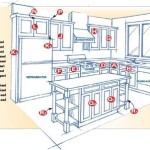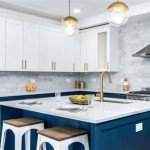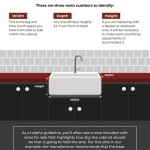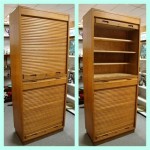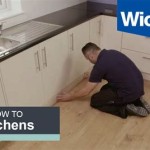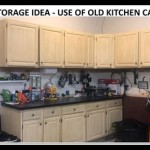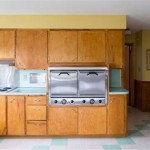Kitchen Cabinet Keeps Opening: Troubleshooting and Solutions
A persistently opening kitchen cabinet door is a common household frustration. It can be caused by a variety of factors, ranging from simple alignment issues to more complex problems with the cabinet hardware. Understanding the potential causes is the first step in implementing an effective solution. This article examines the common reasons why kitchen cabinets may not stay closed and provides detailed guidance on how to address each issue.
Problem 1: Misalignment and Warping
One of the most frequent culprits behind perpetually opening cabinets is misalignment. This occurs when the cabinet door or the cabinet frame is no longer perfectly square, preventing the door from properly engaging with the latch or magnets that hold it shut. Misalignment can stem from several sources, including the settling of the house, humidity changes that warp wood, or simple wear and tear over time. A warped door, particularly, will struggle to maintain consistent contact with the frame, regardless of the latching mechanism.
To diagnose misalignment, begin by visually inspecting the cabinet door and frame. Look for gaps or uneven spacing along the edges of the door when it's closed. A noticeable difference in spacing at the top versus the bottom, or along the sides, suggests a misalignment issue. A warped door can often be identified by placing a straight edge against its surface. Gaps between the straight edge and the door indicate warping.
Addressing minor misalignment problems can often be achieved by adjusting the cabinet hinges. Most modern cabinet hinges are adjustable, allowing for slight lateral, vertical, and depth adjustments. Loosening the hinge screws (usually Phillips head) slightly allows for minute repositioning of the door. Tightening the screws after adjustment secures the new position. Experimentation may be required to find the optimal placement that allows the door to close flush and remain closed. If the hinges are old or damaged, replacing them entirely with new, adjustable hinges is a viable option.
For more severe warping, the solution becomes more complex. Depending on the severity, attempting to straighten the door may be possible using weights and clamps applied over a period of time. However, this method carries the risk of further damage. In cases of significant warping, replacing the cabinet door entirely is often the most effective and reliable solution. When replacing a door, ensure the new door is properly aligned and installed with adjustable hinges to minimize future issues.
Furthermore, the cabinet frame itself can become misaligned. This is less common than door misalignment but can still contribute to the problem. Inspect the frame for any signs of warping, separation at the joints, or detachment from the wall. If the frame is the issue, it may require reinforcing the joints with wood glue and clamps, or re-securing the frame to the wall studs using longer screws. In extreme cases, professional cabinet repair or replacement may be necessary.
Problem 2: Faulty or Weak Cabinet Hardware
The hardware responsible for keeping the cabinet door closed, such as latches, magnets, and catches, can degrade or fail over time. Constant use and exposure to moisture and grease can weaken their effectiveness, leading to the door popping open unexpectedly. Identifying the specific type of hardware used in the cabinet is crucial for diagnosing the problem and selecting the appropriate repair or replacement.
Magnetic catches are a common type of cabinet hardware. They consist of a magnetic strip on the cabinet frame and a metal plate on the door. The magnet is designed to hold the door closed with sufficient force. Over time, the magnet can lose its strength, or the metal plate can become misaligned, reducing the holding power. To test the magnetic catch, check if the magnet feels weak or if the metal plate is loose. If the magnet is weak, it can be replaced with a new, stronger magnet. If the metal plate is misaligned, adjust its position so that it makes full contact with the magnet when the door is closed.
Roller catches are another type of cabinet hardware that uses a spring-loaded roller that engages with a strike plate on the cabinet frame. As the door is closed, the roller compresses, creating tension that holds the door shut. Over time, the roller mechanism can become stiff or the spring can weaken, reducing its effectiveness. Lubricating the roller mechanism with a silicone-based lubricant can often improve its performance. If the roller catch is severely worn or damaged, replacing it with a new one is the best course of action.
Other types of latches, such as ball catches or touch latches, can also experience wear and tear. Ball catches use a spring-loaded ball that engages with a recess in the cabinet frame. Touch latches use a spring-loaded mechanism that releases the door when pressed. Inspect these latches for signs of wear, damage, or misalignment. Lubrication may help, but replacement is often necessary if the latch is failing to function properly.
When replacing cabinet hardware, ensure that the new hardware is compatible with the existing cabinet design and dimensions. Measure the existing hardware carefully and select a replacement with similar specifications. Also, consider upgrading to higher-quality hardware for increased durability and performance. Stainless steel hardware, for example, is more resistant to corrosion and wear than cheaper alternatives.
Problem 3: Obstructions and Internal Pressure
Sometimes, the reason a cabinet door won't stay closed is not due to the hardware or alignment, but rather due to internal factors within the cabinet itself. Overstuffing the cabinet can create internal pressure that forces the door open. Similarly, items inside the cabinet may be obstructing the door's closing mechanism.
Begin by examining the contents of the cabinet. Look for items that are protruding beyond the cabinet's edges or pressing against the door. Rearrange the contents to create more space and ensure that no items are interfering with the door's closing. Consider decluttering the cabinet to reduce the overall volume of items stored inside. This can alleviate internal pressure and make it easier for the door to stay closed.
In some cases, the problem might be due to an object that is not immediately visible. Small items, such as utensils or containers, can sometimes fall behind other items and obstruct the door's path. Remove all the contents of the cabinet and thoroughly inspect the interior for any hidden obstructions.
In addition to physical obstructions, consider the pressure dynamics inside the cabinet. Stacking items too high can create a concentrated force that pushes against the door. Distribute the weight of the contents evenly throughout the cabinet to minimize pressure points. Use dividers or organizers to create distinct compartments and prevent items from shifting and pressing against the door.
Another potential pressure-related issue can stem from improperly installed or malfunctioning drawer slides within the cabinet itself. If a drawer is not sliding smoothly, it can create resistance that transmits force to the cabinet door, causing it to pop open. Inspect the drawer slides for any signs of damage or misalignment. Lubricate the slides with a silicone-based lubricant to ensure smooth operation. If the slides are severely worn or damaged, replace them with new ones.
Addressing these internal factors often involves a combination of decluttering, reorganizing, and maintaining the internal components of the cabinet. By carefully managing the contents and ensuring smooth operation of internal mechanisms, one can prevent pressure-related issues from causing the cabinet door to open unexpectedly.
By systematically investigating potential causes, ranging from misalignment and hardware issues to internal obstructions, individuals can effectively troubleshoot and resolve the problem of a kitchen cabinet that refuses to stay closed. Patience and a methodical approach are key to identifying the root cause and implementing the appropriate solution.

Fail Proof Method For Keeping Kitchen Cabinet Doors Closed

Tips For Fixing A Cabinet Door That Won T Stay Closed Hinge

Cabinet Door Keeps Popping Open Here S What You Can Do

7 Ways To Keep Your Kitchen Cabinets Clean Looking New

Diy Budget Open Kitchen Cabinets Build Your Own In A Weekend

Renovating A Small Kitchen Keep These Interior Design Tips In Mind Yang S Inspiration

Renovating A Small Kitchen Keep These Interior Design Tips In Mind Yang S Inspiration

Renovating A Small Kitchen Keep These Interior Design Tips In Mind Yang S Inspiration

Diy Budget Open Kitchen Cabinets Build Your Own In A Weekend

Pros And Cons Of Upper Kitchen Cabinets Versus Open Shelves
Related Posts

